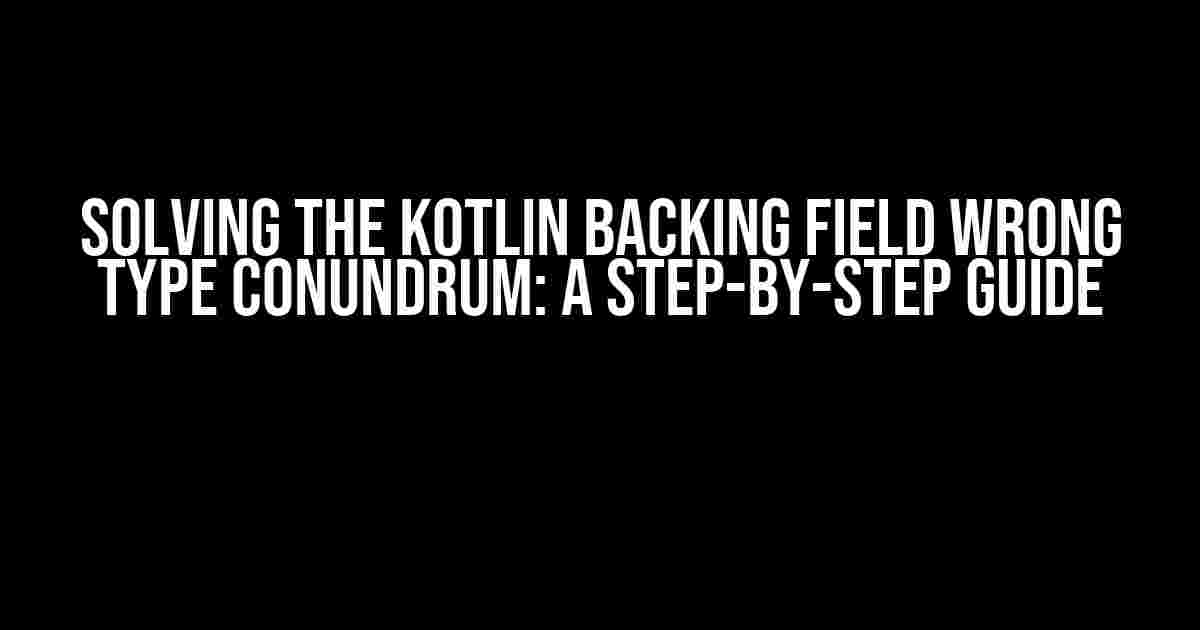Are you tired of getting stuck with the notorious “Kotlin backing field wrong type” error? You’re not alone! This common issue has been a thorn in the side of many developers, causing frustration and headaches. But fear not, dear reader, for we’re about to dive into a comprehensive guide that will demystify this error and provide you with the tools to tackle it once and for all.
What is a Kotlin Backing Field?
Before we dive into the meat of the problem, let’s take a step back and understand what a Kotlin backing field is. In Kotlin, a backing field is a private property that is used to store the value of a public property. Think of it as a behind-the-scenes hero that does all the heavy lifting for your property.
var myProperty: String = ""
private set(value) {
field = value
}In this example, `myProperty` is the public property, and the private `field` is the backing field. When you set a value to `myProperty`, the setter function is called, which in turn updates the backing field.
The Kotlin Backing Field Wrong Type Error
Now, let’s talk about the error that’s got you pulling your hair out. When you encounter the “Kotlin backing field wrong type” error, it usually means that there’s a type mismatch between the public property and the backing field.
var myProperty: String = ""
private set(value: Int) {
field = value // Error: Type mismatch: inferred type is Int but String was expected
}In this example, the public property `myProperty` is defined as a `String`, but the setter function expects an `Int` parameter. This mismatch is what triggers the error.
Causes of the Error
Before we dive into the solutions, let’s identify some common causes of the “Kotlin backing field wrong type” error:
- Type mismatch between the public property and the setter parameter
- Type mismatch between the public property and the backing field
- Incorrect use of type aliases
- Complex property initializers
Solutions to the Kotlin Backing Field Wrong Type Error
Now that we’ve identified the causes, let’s get to the good stuff – the solutions!
Solution 1: Align the Types
One of the most straightforward solutions is to ensure that the types of the public property, setter parameter, and backing field are aligned.
var myProperty: String = ""
private set(value: String) {
field = value
}In this example, we’ve changed the type of the setter parameter to `String`, which matches the type of the public property and the backing field.
Solution 2: Use Type Casting
Sometimes, you might need to perform type casting to resolve the type mismatch.
var myProperty: String = ""
private set(value: Any) {
field = value as String
}In this example, we’re using the `Any` type for the setter parameter, which allows us to accept any type of value. We then use type casting to convert the value to a `String` before assigning it to the backing field.
Solution 3: Use a Custom Setter
If you’re working with complex property initializers or custom logic, you might need to create a custom setter function.
var myProperty: String = ""
private set(value: Int) {
field = value.toString()
}In this example, we’re using a custom setter function that takes an `Int` parameter and converts it to a `String` before assigning it to the backing field.
Solution 4: Use a Type Alias
Type aliases can be a powerful tool in Kotlin, but they can also lead to type mismatches. If you’re using a type alias, make sure it’s correctly defined.
typealias MyType = String
var myProperty: MyType = ""
private set(value: MyType) {
field = value
}In this example, we’ve defined a type alias `MyType` as a `String`. We can then use this type alias consistently throughout our code.
Best Practices to Avoid the Kotlin Backing Field Wrong Type Error
To avoid the “Kotlin backing field wrong type” error in the first place, follow these best practices:
- Use consistent type naming conventions
- Keep your property declarations concise and clear
- Avoid complex property initializers
- Use type aliases sparingly and correctly
- Test your code thoroughly
Conclusion
The “Kotlin backing field wrong type” error might seem daunting at first, but with a solid understanding of the causes and solutions, you’ll be well-equipped to tackle it head-on. By following the best practices outlined in this article, you’ll be able to write clean, concise, and error-free code that will make you the envy of your fellow developers.
Remember, practice makes perfect, so don’t be afraid to experiment and try out different solutions. And if you’re still stuck, don’t hesitate to reach out to the Kotlin community for help.
| Error Cause | Solution |
|---|---|
| Type mismatch between public property and setter parameter | Align the types |
| Type mismatch between public property and backing field | Align the types |
| Incorrect use of type aliases | Use a type alias correctly |
| Complex property initializers | Use a custom setter function |
By following the guidelines outlined in this article, you’ll be well on your way to becoming a Kotlin master. Happy coding!
Frequently Asked Question
Kotlin’s got a trick up its sleeve, or should I say, a gotcha up its sleeve? One of the most frustrating errors you’ll encounter is the “Kotlin backing field wrong type” error. Don’t worry, we’ve got the lowdown on how to tackle this pesky problem!
What is the “Kotlin backing field wrong type” error?
The “Kotlin backing field wrong type” error occurs when the type of the backing field in a property does not match the type of the property itself. This can happen when you’re using a custom getter or setter, and the type of the field does not match the type of the property. It’s a bit like trying to put a square peg in a round hole, it just won’t fit!
Why does Kotlin require a backing field?
Kotlin requires a backing field to store the value of a property. This is because properties in Kotlin are not just simple variables, but rather a way to expose a value to the outside world while still maintaining control over how it’s accessed and modified. The backing field is the actual storage for the property, and it needs to match the type of the property to ensure type safety.
How do I fix the “Kotlin backing field wrong type” error?
To fix the error, you need to ensure that the type of the backing field matches the type of the property. You can do this by explicitly specifying the type of the field, or by using a compatible type. For example, if you have a property of type `String`, the backing field should also be of type `String`. It’s like matching the right key to the right lock, once you get it right, everything will fall into place!
Can I use a different type for the backing field?
While it’s technically possible to use a different type for the backing field, it’s not recommended. Using a different type can lead to type casting issues and potential runtime errors. It’s like trying to fit a square peg into a round hole, it might seem to work at first, but it’ll eventually cause problems. It’s best to stick with the type that matches the property to ensure type safety and avoid potential issues.
What are some best practices to avoid the “Kotlin backing field wrong type” error?
To avoid this error, make sure to explicitly specify the type of the backing field and ensure it matches the type of the property. Use compatible types, and avoid using implicit types. Also, use the `lateinit` keyword or the `(nullable)` syntax to specify the type of the field. By following these best practices, you’ll be well on your way to avoiding this pesky error and writing robust, type-safe Kotlin code!



